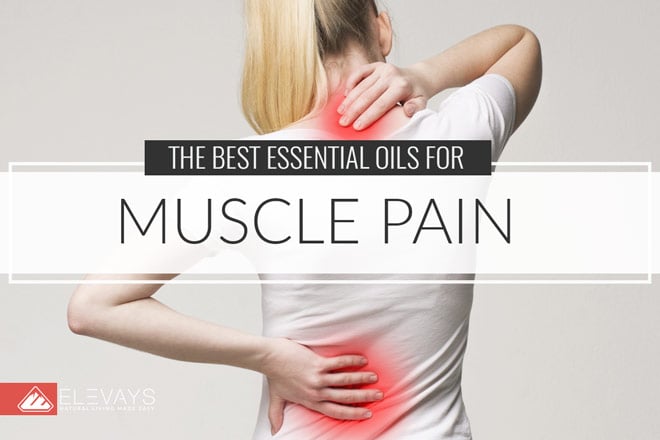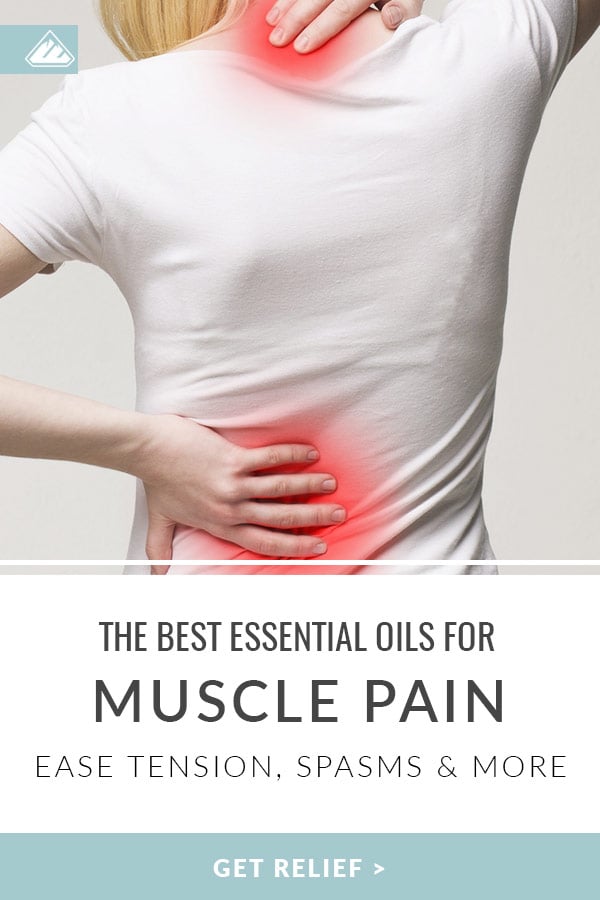Sore muscles, swelling, and inflammation are all common woes of life. Whether they are due to an intense workout, a clumsy fall, or just a long week of not stretching and not getting enough movement, they are bound to show up. And this is why we’re talking essential oils for muscle pain.
My husband and I like to get a good workout at least a couple times a week to stay physically and mentally sharp, and the best way to stay consistent with that is to use essential oils for muscle pain. If you’re a regular reader at our blog, than you know your girl is not going to reach for icy-hot, advil, or any other OTC medication – you better believe I’m using my essential oils.
Acetaminophen, the common ingredient in Tylenol, may be considered the safest over-the-counter pain reliever when compared to NSAIDS that cause tummy and heart issues. Doctors even allow pregnant women to take acetaminophen in small doses. However, recent research shows the medication comes with more risks than we previously thought.
TRUTH BOMB:
You’re
Already killing it!
If You Were More Consistent With Your Wellness Routine, You’d Be Unstoppable.
Opting for essential oils is much safer than reaching for over-the-counter pain meds like Tylenol, which studies show can lead to a lack of empathy (1), liver damage (2), increased risk of blood cancer (4), potentially fatal skin reactions (3), and in large quantities over time, even death (5).
If that’s not bad enough, studies also show kids who use acetaminophen before three years old are more likely to develop asthma (6), autism (7), and ADHD (8).
I know that was intense for the beginning of this article – but why reach for something with potential side effects when you can reach for a natural alternative that has no side effects when used properly and is safe for daily use?
In this post, I’ll show you exactly which essential oils for muscle pain you should keep in your medicine cabinet. They’re even great additions to your gym bag or evening bath!
Essential Oils for Muscle Pain: Use for Spasms and Pain
The best way to use essential oils for muscle pain, swelling, or inflammation is to apply them to the area topically. Make sure to combine them with a carrier oil or lotion thoroughly before placing the oil directly on your skin. Fractionated coconut oil is an ideal carrier because it comes with added skin-loving benefits, but it also relaxes your muscles. We also love jojoba oil!
You can place the diluted oil in a roll-on bottle or carry the oil with you to the gym in an essential oil travel bag. Topical massages are another great way to relieve pain and swelling, and you can even add a couple of drops of essential oil to your nightly bubble bath for relaxing relief. These are the best (and some of our favorites) essential oils for relieving muscle pain.
- Peppermint: The analgesic, antispasmodic, and anti-inflammatory properties can relieve pain and inflammation as well as calm spasms and muscle cramps. The menthol in peppermint oil further soothes achy muscles.
- Ginger: When used topically, the warming sensation relieves pain in sore muscles.
- Eucalyptus: Produces a cooling effect that aids sore muscles and inflammation.
- Rosemary: Eases pain and inflammation. Infuse the oil in a bath or apply it directly onto painful areas.
- Valerian: A natural sedative, this oil relieves menstrual cramps and muscle aches.
- Sandalwood: Helps with tension, muscle spasms, and muscle inflammation.
- Clary sage: Alleviates muscle tension and spasms, promoting long-term relaxation.
- Juniper: Eliminates muscle spasms on contact.
Essential Oils for Swelling and Inflammation: Use for Injury-Related Inflammation
When your pain and swelling result from a new injury, turn to these essential oils for inflammation:
- Peppermint: The best oil for injuries, it works well for muscle, back, and leg pain.
- Lavender: Relaxing and soothing, lavender also relieves pain and inflammation. It’s perfect for diffusing, inhaling, topical application, massage, or a bath.
- Roman chamomile: The best oil for inflammation and muscle aches (9), try using a warm compress with 2-3 drops of oil.
- Helichrysum: Relieves spasms, pain, and inflammation in tired muscles. You can apply it topically to prevent bruising as well as relieve pain and skin swelling.
- Arnica: Relieves inflammation and swelling, while soothing and reducing bruising (12).
For long-term or chronic swelling, try the following essential oils for chronic inflammation:
- Frankincense: For thousands of years, frankincense has treated tons of ailments, including chronic pain and inflammation. The cool part about frankincense is that it goes deep to the cellular level to rebuild.
- Thyme: Contains a powerful anti-inflammatory called carvacrol for various uses.
- Clove: Studies show the eugenol in clove is high in anti-inflammatory and pain-relieving properties (10).
- Ginger: Add more ginger to your meals for chronic inflammation and pain management.
There are also DoTerra essential oils for inflammation that are safe for daily, long-term use like thyme and oregano. However, you can receive the best DoTerra oil for inflammation through their Deep Blue line, which is available as an oil, topical rub, roll-on, or lotion. Deep blue is a lifesaver in our family.
Essential Oils for Joint Pain: Use for Joint-Related Swelling and Inflammation
Swelling and inflammation are common with joint pain, which often begins after an injury or with the onset of arthritis. To be honest, I think most of us who work on a computer, typing all day, hunched over (hello shoulder and neck pain) are all on the road to joint pain. Using essential oils can help combat this. Apply the oils directly to the painful region using a carrier for the best results.
The most well-known and loved healing oils for pain include:
- Eucalyptus: A 2013 study shows that by simply inhaling eucalyptus essential oil for 30 minutes per day helps people who have had a total knee replacement surgery (13). It soothes inflammation and reduces pain.
- Chamomile (Roman and German): Both chamomile oils aid inflammation and joint pain by improving your blood flow. They also soothe tension and reduce spasms in sore muscles. Drink an herbal chamomile tea for inner results or massage it into the painful area.
Essential oils for arthritis inflammation:
- Juniper: Relieves stiffness and pain in the joints, and effectively treats rheumatoid arthritis when applied directly to the joint.
- Ginger: The anti-inflammatory properties treat joint pain and inflammation from arthritis and even eases muscle stiffness.
- Lemongrass: Quickly reduces inflammation and swelling related to arthritis (11).
- Sandalwood: Treats many of the painful symptoms associated with rheumatic conditions.
- Vetiver: The anti-inflammatory properties reduce swelling in the joints, making it an ideal medicine for arthritis.
- Primrose: The Arthritis Foundation recommends taking 2.8 grams of evening primrose daily for arthritis.
Essential oils for joint inflammation:
- Ginger: Alleviates joint pain thanks to the anti-inflammatory and analgesic properties.
- Sandalwood: Fights inflammation and pain in the joints while helping to relax muscle spasms and relax your nervous system.
- Basil: Reduces swelling in the joints and lowers your risk of further cartilage damage.
Here are a few other options you can try to ease your knee pain. The best essential oils for knee inflammation include:
- Sandalwood: Ideal for inflammation and pain in the knee.
- Yarrow: Reduces pain and inflammation in inflamed joints and is excellent for topical application if you have an inflammatory skin condition as well.
- Lavender: A 2016 study shows lavender oil diluted with sweet almond oil helps knee inflammation (14).
Everyone is different. Once you find a relaxing essential oil that works well for your muscle pain or joint inflammation, use it regularly. This article includes a large variety of options because everyone enjoys the smell of different oils. While all these oils work hard to help inflammation and muscle pain, you may prefer the scent of one over the other. So once you figure out what oil pleases you, go for it.
Sources:
- Mischkowski, Dominik, Crocker, Jennifer, and Baldwin M. Way. (2016). From painkiller to empathy killer: acetaminophen (paracetamol) reduces empathy for pain. Retrieved from: https://www.ncbi.nlm.nih.gov/pmc/articles/PMC5015806/
- The United States Food and Drug Administration. (2009). Acetaminophen: Avoiding Liver Injury. Retrieved from: https://www.fda.gov/consumers/consumer-updates/acetaminophen-avoiding-liver-injury
- Sifferlin, Alexandra. (2013). Acetaminophen Linked to Fatal Skin Reactions. Retrieved from: http://healthland.time.com/2013/08/02/acetaminophen-linked-to-fatal-skin-reactions/
- Walter, Roland B., Milano, Fillippo, White, Emily, and Theodore M. Brasky. (2002). Long-Term Use of Acetaminophen, ASpirin, and Other Nonsteroidal Anti-Inflammatory Drugs and Risk of Hematologic Malignancies. Retrieved from: https://ascopubs.org/doi/full/10.1200/JCO.2011.34.6346
- Harvard Health Publishing. (2009). Overdosing acetaminophen. Retrieved from: https://www.health.harvard.edu/heart-health/overdoing-acetaminophen
- Sakulchit, Teeranai and Ran D. Goldman. (2017). Acetaminophen use and asthma in children. Retrieved from: https://www.ncbi.nlm.nih.gov/pmc/articles/PMC5349720/
- Avella-Garcia, Claudia B., et al. (2016). Acetaminophen use in pregnancy and neurodevelopment: attention function and autism spectrum symptoms. Retrieved from: https://academic.oup.com/ije/article/45/6/1987/2617189
- Epidemiol, Am J. (2018). Prenatal Exposure to Acetaminophen and Risk for Attention Deficit Hyperactivity Disorder and Autistic Spectrum Disorder: A Systematic Review. Retrieved from: https://www.ncbi.nlm.nih.gov/pubmed/29688261
- Lakhan, Shaheen E., et al. (2016). The Effectiveness of Aromatherapy in Reducing Pain: A Systematic Review and Meta-Analysis. Retrieved from: https://www.hindawi.com/journals/prt/2016/8158693/
- Asi, Mina Kamkar, et al. (2013). Analgesic effect of the aqueous and ethanolic extracts of clove. Retrieved from: https://www.ncbi.nlm.nih.gov/pmc/articles/PMC4075701/
- Kebir, Hadjer Tchoketch, et al. (2014). Lemongrass essential oil as a potent anti-inflammatory and antifungal drug. Retrieved from: https://www.tandfonline.com/doi/full/10.3402/ljm.v9.25431
- Pumpa, Kate L. (2013). The effects of topical Arnica on performance, pain, and muscle damage after intense eccentric exercise. Retrieved from: https://www.tandfonline.com/doi/abs/10.1080/17461391.2013.829126
- Yang Suk Jun, et al. (2013). Effect of Eucalyptus Oil Inhalation on Pain and Inflammation Responses after Total Knee Replacement: A Randomized Clinical Trial. Retrieved from: https://www.hindawi.com/journals/ecam/2013/502727/abs/
- Metin, Zehra Gok and Leyla Ozdemir. (2016). The Effects of Aromatherapy Massage and Reflexology on Pain and Fatigue in Patients with Rheumatoid Arthritis: A Randomized Controlled Trial. Retrieved from: https://www.researchgate.net/profile/Leyla_Ozdemir/publication/301344191_The_Effects_of_Aromatherapy_Massage_and_Reflexology_on_Pain_and_Fatigue_in_Patients_with_Rheumatoid_Arthritis_A_Randomized_Controlled_Trial/links/59df0847458515376b386139/The-Effects-of-Aromatherapy-Massage-and-Reflexology-on-Pain-and-Fatigue-in-Patients-with-Rheumatoid-Arthritis-A-Randomized-Controlled-Trial.pdf











This is a super helpful list. Thank you for all your research!
Kindest regards,
Boston Clavering
So glad that it was helpful!